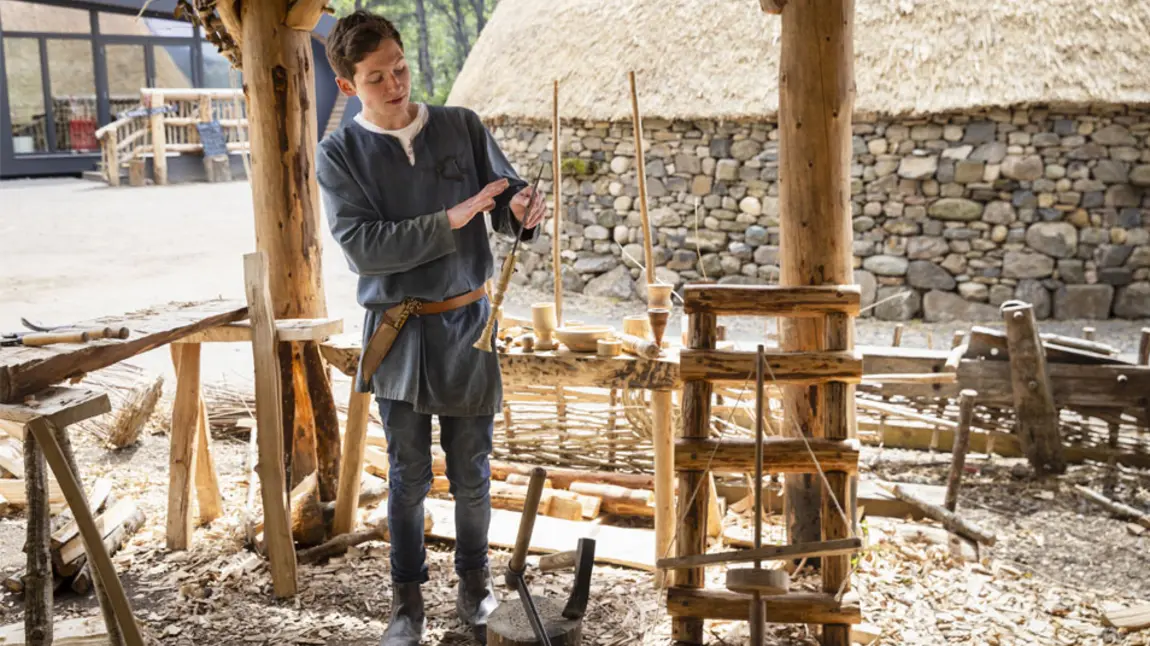Case study: The Scottish Crannog Centre

The ambition
The Scottish Crannog Centre is rebuilding and revitalising its open-air Iron Age replica village and museum on the edge of Loch Tay.
The new site was created by and for the local community, with over 1,000 people taking part and over 20,000 volunteer hours recorded between 2023 and 2024.
The organisation
A visitor attraction since 1997, The Scottish Crannog Centre previously housed a replica ‘crannog’, a pre-historic loch dwelling. Seventeen of these historic dwellings were excavated on the loch-side.
In 2021, a fire destroyed the reconstructed crannog. Staff, volunteers and craftspeople came together to rebuild and develop the centre into something even bigger than before.
On 1 April 2024, the site was re-opened with a new visitor centre, seven reconstructed roundhouses, ancient artefacts and hands-on craft activities enabling visitors to step back in time into an Iron Age village.
Sustainable Project of the Year Award
The Scottish Crannog Centre was recognised at the Museums + Heritage Awards in 2024 for its commitment to environmental sustainability. It won the award jointly with Manchester Museum and Museum Development North.
To win the sustainability award just two months after re-opening was such a boost for everyone here.
Rachel Backshall, Assistant Director at The Scottish Crannog Centre
Sustainability is rooted in every aspect of the centre's operations and governance. It reuses, recycles and regenerates natural resources to minimise waste and energy consumption.
All building materials such as hazel coppice were taken from local land to construct the dwellings, using Iron Age methods. The centre has built partnerships between coppice workers and landowners to develop sustainable land management practices.
It has also invested in developing local skills and networks to sustain a local workforce and support the museum's future.
Rachel Backshall, Assistant Director at The Scottish Crannog Centre, says: “The lack of training opportunities in a rural area can lead to many young people moving away. That’s why we’ve created an apprenticeship scheme to help people to develop skills locally. We want to build and maintain a local workforce, to support places like our museum so that more people can experience this important and fascinating heritage.”
To continue to embed this practice, the centre builds training time into workers’ contracts so that they can pass on their valuable skills and knowledge to others.
Reflecting on the success, Rachel says: “To win the sustainability award just two months after re-opening was such a boost for everyone here. It validates all the hard work and recognises the thousands of people who have been involved, from giving donations after the fire to volunteering their time and skills in the re-build.”
The results
Being open to the community and listening to how people want to get involved has been key to getting strong local engagement.
Troy, a volunteer at the centre, says: “I think the biggest lesson I’ve learned from building an Iron Age village is the importance of community and having communal spaces, having spaces for people to hang out and be themselves.”
The centre is not only rooted in the landscape but also in the community who feel a sense of pride over what has been achieved together.
The future
The site has re-opened, but the work is not finished. A new crannog will be built from September and there are plans to create a new museum, social housing and more training opportunities.
The centre aims to further its commitment to sustainability and become Scotland's most sustainable museum.
Top tips
Rachel shares some of the main lessons learned during the process:
- Build connections with your local community. Listen to their needs and perspectives, this will help to build long-standing relationships with the communities we exist to serve.
- Use what you have around you. We used timber and turf from the castle two miles away and heather from the Schiehallion mountain. This has helped to build a sense of place as well as being environmentally-friendly.
- Invest in people. Provide training and upskilling opportunities and diversify your workforce so they can best connect to the diverse audiences that visit.
- Be open and show trust. Only by trusting the people we work with entirely can we create something truly special.
Funding for your heritage project
Find out more about our investment principle Protecting the environment to explore the difference we want our funding to make for nature and the environment.




